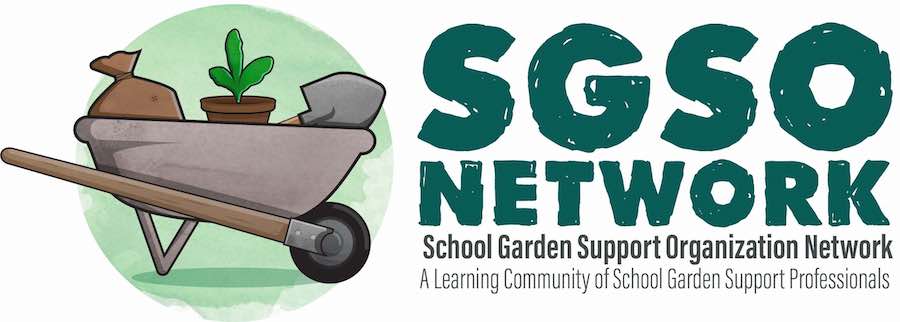Teaching outdoors presents opportunities and challenges that are unique from the indoor environment. Fortunately, with effective Outdoor Classroom Management (tips on that below!) and Outdoor Classroom Design, just about any traditional classroom activity can translate well to an outdoor setting.
View our webinar archive on In-person Outdoor Instruction During Covid
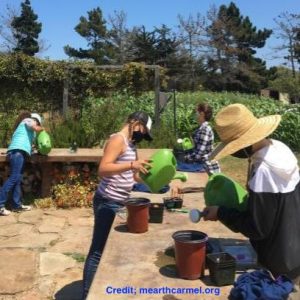
Traditional Classroom Activities that Are Well-Suited to the Outdoor Classroom
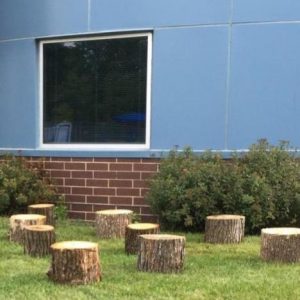
COVID-Specific Considerations for Teaching Outdoors
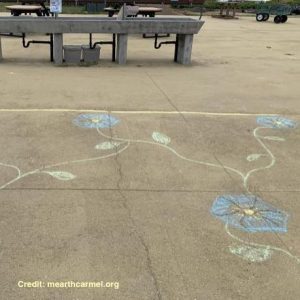
Tips for Teaching (Anything!) Outdoors
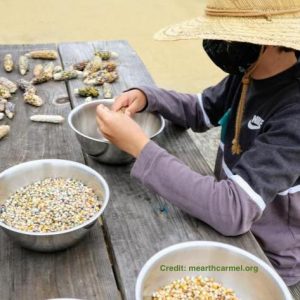
Environmental Education Curricula Designed to be Taught Outdoors
Traditional Classroom Activities that Are Well-Suited to the Outdoor Classroom
Circle Time/Direct Instruction
A circular Outdoor Classroom can work particularly well for activities such as:
- Storytime
- Class meetings, morning meet ups, or any other facilitated circles to support social emotional learning using trauma-informed practices
- Science talks
- Mini-lessons
- Mindfulness Lessons
Independent or Small Group Work
Almost any Outdoor Classroom can provide a good, alternative space for students to engage in independent or small group work, such as:
- Independent reading
- Independent writing: Drafting, revising one another’s work, etc.
- Math practice
- Nature journaling
- Small group collaborative conversations: Book clubs, etc.
Social Emotional Learning
An Outdoor Classroom can provide a wonderful context for Social Emotional Learning activities, such as:
- Mindfulness Exercises: Breathing, Meditation, Sensory Awareness Activities
- Small Group Discussions: Pair Shares, etc.
- Activities from the Grow Outside Toolkit for Social Emotional Learning
Physical Activity
Even prior to the pandemic, the outdoors was known to be an optimal environment for:
- Physical Education (PE)
- Physical icebreakers, stretching, or brain breaks
Environmental and Place-Based Education
There are myriad opportunities to use the natural, outdoor environment to bring earth and life science learning to life.
COVID-Specific Considerations for Teaching Outdoors
 Minnesota Early Childhood Outdoors (MnECO) has created an Outdoor Learning for Schools Toolkit with specific recommendations for teaching outdoors while following social distancing and other COVID guidelines. To download their toolkit, fill out the following form.
Minnesota Early Childhood Outdoors (MnECO) has created an Outdoor Learning for Schools Toolkit with specific recommendations for teaching outdoors while following social distancing and other COVID guidelines. To download their toolkit, fill out the following form.
Outdoor Physical Spaces
- Create a consistent “Base Camp” for each small group of students
- Provide Outdoor Hand Washing Stations that are easily accessible to where groups are. Image above is a possible handwashing station design from NC State’s Young Farmers’ Coalition.
Teaching and Learning Materials
- Reducing Shared Materials:
- Reduce shared materials. For example, create plastic pencil boxes with art materials (colored pencils, glue, scissors, etc). Label each box with a #. Have either 1 set for each student, or 1 for each group (keeping the same # with each student or group)
- Sanitizing:
- Use materials that can be thoroughly sanitized
- Create systems for organizing, tracking & sanitizing shared materials. Create a check-in/out system for shared materials used in the outdoor classroom and sanitize whenever materials are checked in.
- Always have a bucket of soap and water ready for the materials to be put in when done. Have sanitizing wipes for the materials that cannot be submerged.
- Reducing Shared Materials:
Social Distancing
- Strategically use spaces where students can spread out
- Explicitly teach students what 6ft apart looks like, and practice polite language for reminding one another to stay 6 ft apart.
- Use hula hoops, vinyl spot markers, chalk on blacktop, or other visual cue so that children know where to sit or stand.
Masks
- If masks are required, create a space near the entrance to the Outdoor Classroom “Base Camp” where students are reminded to put on their masks.
- Practice language together for reminding one another to wear masks, pull them over mouth and nose, etc.
Tips for Teaching (Anything!) Outdoors
As educators consider moving traditional classes outdoors in response to COVID-19, Life Lab’s long-time school garden educators offer the following tips for making outdoor teaching and learning safe, effective, and enjoyable.
- Outdoor Classroom Design: Design the Outdoor Classroom space so that it is easy for students to focus and reflect the behavior expectations. For example:
- Explore the Outdoor Classroom ahead of time to identify and address any hazards, like stinging nettle or wasps’ nests.
- Mark an entrance area to the Outdoor Classroom to distinguish it from recess areas, and make a little routine for “passing through the threshold and into the Outdoor Classroom.”
- Provide a shaded gathering area with comfortable seating.
- Provide clipboards so papers don’t fly away, and tables to make the space function well as a classroom.
- Keep a first aid kit, sunscreen, hand washing supplies, and drinking water in your Outdoor Classroom.
- Create a sound-barrier if possible, between the Outdoor Classroom and any noisy roadways, soccer fields, or the like.
- Comfort: Help students stay comfortable. Provide warm clothing if your students need it. When you’re addressing the group, wear a sunhat and look into the sun so that your students don’t have to.
- Language: When introducing the space, use language that reflects the goals of the space, such as “outdoor classroom.”
- Group Agreements: Clarify for yourself and for your students what types of behaviors are appropriate in the Outdoor Classroom, and how expectations will be similar to, and/or different from, the indoor classroom. Toward that end, at the beginning of your first Outdoor Classroom experience, discuss the importance of staying safe and respecting all living things, including plants, animals, one another, and the adults in the Outdoor Classroom. Emphasize social distancing. Enlist students’ ideas to establish a simple list of Outdoor Classroom Behaviors, including how to respond to a distraction; what to do if you become too hot, cold, uncomfortable; etc.
- Routines: Create and follow predictable routines, such as starting each class by looking around for a moment to notice things that have changed; then gathering in a circle to talk about the main idea and activities for the day; and then reviewing behavior expectations.
- Start with Exploration: Provide an opportunity at the beginning of each outdoor class for students to look around, perhaps taking a moment to notice something that’s changed, or something that is interesting or beautiful. Taking a little time to acknowledge the distractions at the outset can help reduce them later on.
- Call Back: If you are sending students out and around to explore — for a scavenger hunt, for example — establish a call back signal, such as a coyote howl or a ringing gong, to let students know when it is time to return to the circle.
- Practice: For any new routine, introduce it to your students, and then practice together to help them really learn it.
Environmental Education Curricula Designed to be Taught Outdoors
The following environmental literacy curricular resources are designed to be taught outdoors:
- How to Teach Nature Journaling, J.M. Laws
- Lead Outdoor Science Experiences, BEETLES Project, Lawrence Hall of Science
- The Growing Classroom, Life Lab
- Outdoor Biology Instructional Strategies, Lawrence Hall of Science
- Project WET
- Project WILD and Project Aquatic Wild
- Project Learning Tree
- Getting Started with Place-Based Education
- The Wonders of Wetlands
- Model Inquiries Into Nature for Teaching Science
- Taking FOSS Outdoors (homepage includes videos from Boston Schoolyard Initiative)
- Taking FOSS Outdoors (K-5) PDF
- Taking FOSS Middle School Outdoors PDF
- There are also so many localized resources for most regions, from museums, aquaria, zoos, local parks, local natural resource boards, etc.
The resources and ideas on this page were influenced from a National Covid Outdoor Learning Initiative Working Group. Learn more about integrating outdoor learning into schools.
